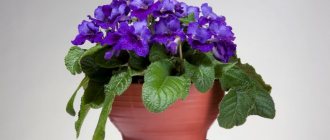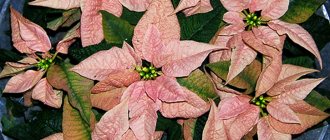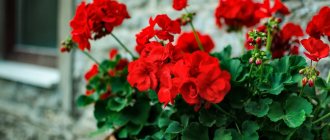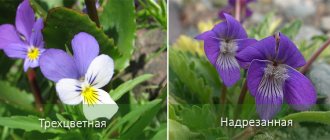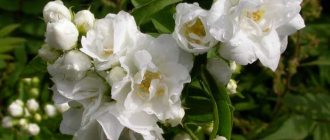Description
Godetia grows as a bush. It may have a pyramidal or spreading shape. Godetia reaches a height of 60 cm and has grassy shoots in early summer. Over time they become woody.
The leaves on the shoots are arranged alternately. They are narrow and elongated. The flowers of this plant can be monochromatic or multi-colored. Their shade depends on the variety of godetia. The flower can be white, pink, burgundy, peach or scarlet.
Godetia flowers have the shape of a bell or rose (double). They are collected in inflorescences in the form of a brush. This plant blooms from July until late autumn (around the end of October). Each of its flowers remains open in any weather.
When frost occurs, cylindrical boxes with seeds appear on godetia. You can get a new plant from seeds if planted within 3-4 years after collection. They cannot be stored longer, because the godetia seeds will lose their viability.
general information
Godetia is a beautiful herbaceous annual that grows well on the site and in the apartment. It has a branched, erect stem that stretches 20-60 cm, depending on which variety you prefer. As a result, neat pyramid bushes with voluminous bells grow.
Godetia flowers are quite large and for some varieties can reach 10 cm. They are united in voluminous inflorescences on short peduncles - smooth or lush double. The main color scheme is all shades of pink, but there are also different variations from white to red.
Photo: ladyflor.ru
Types and varieties of godetia
Scientists have identified twenty species of godetia. Each of them includes different varieties. But in our country, large-flowered, double and lovely godetia are especially popular, since these species tolerate the Russian climate well.
Godetia grandiflora
Godetia grandiflora is a relatively low plant. The length of its shoots does not exceed 40 cm. The bush has leaves tapering towards the base and large bell-shaped flowers (up to 100 mm in diameter).
The flowers are collected in a raceme at the tip of the stems. Their shade can be white, pink, lilac, red, scarlet, crimson or dark red. The following varieties belong to this type:
- Orange Room is a godetia up to 50 cm high with a semi-spreading bush shape. The green-red hue of the stem and narrow leaves are one of the characteristics of this variety. Flowers reach a diameter of up to 50 mm and have the shape of a wide bell. They are red-orange with a smooth edge of the petals.
- Weisser Schwann is a compact godetia no more than 35 cm high. It has light brown shoots below and green above. The flowers of the plant are satiny white, cup-shaped. They have petals with smooth edges and reach a diameter of 60 mm.
- Summer's Darling is a godetia with pink and burgundy flowers.
- Sybil Sherwood are small, creeping bushes up to 40 cm high. They delight the eye with bright pink inflorescences.
- Memoria is a white flowered variety. If you look closely, you can see a slight shade of pink.
- Rembrandt - godetia with pink flowers covered with red spots.
- Meteor is a variety with dark scarlet bell-shaped flowers. The petals of the bells have a velvety surface.
- Maiden Blush is a plant with creamy white flowers. This shade fades to hot pink at the base of the cup.
- Orange Glory - godetia with soft pink inflorescences.
- Satin Rose is a variety with pink-cream flowers. Satin Rose's petals are wavy at the edges.
Godetia amoena
The lovely godetia grows up to 60 cm in height. It has erect stems with a smooth surface.
Over time, the shoots partially become woody. This plant has narrow, pointed leaves and cup-shaped flowers up to 50 mm in diameter. The flower petals are colored raspberry-lilac or red-pink (there are other shades of red).
This type includes the following varieties:
- Kirshkenigin - godetia with pink-red flowers.
- Crystal Snowflake is a tall bush variety. Their height reaches 75 cm. This godetia has white flowers.
- GraceRosePink is also a tall variety. It has bright crimson inflorescences.
- Satin is a compact representative of the species with pink bell-shaped flowers. Their petals become darker as they approach the middle.
- Scarlet Red is a variety of godetia with pink-red inflorescences. Scarlet Red's petals are lighter near the center.
Godetia terry
Terry godetia, as a separate species, does not exist in nature. Lush flowers are found in all other species. The variety Rembrandt from the large-flowered category and Sybil Sherwood also have double inflorescences. Other popular varieties:
- Diamond. It is characterized by bright red inflorescences with white spots.
- The bride is a godetia with white flowers. If you look closely, you can notice a soft pink tint.
Godetia – photo
Godetia flowers are so similar and at the same time so different. They are ideal for creating lush flower arrangements in the garden or country house. Just look at the photos in our selection!
Photo: mkdou19.ru
Photo: stroy-podskazka.ru
Photo: ogorodnik.com
Photo: letselsovet.ru
Photo: m.nn.ru
Photo: 2sotki.ru
Photo: cvetokras.ru
Photo: fotoload.ru
Photo: artfile.ru
Photo: rastenieinfo.ru
Photo: parnasse.ru
Photo: ogorod-bez-hlopot.ru
Photo: dachnaya-zhizn.ru
Photo: plodogorod.com
Photo: ya-fab.ru
Photo: 2sotki.ru
Photo: 56441950961807.my-6-sotok.rf
Photo: blog-o-cvetax.blogspot.com
Photo: otomatah.ru
Photo: rastenieinfo.ru
Photo: 2sotki.ru
Photo: koffkindom.ru
Photo: u-florista.ru
Photo: blog-o-cvetax.blogspot.com
Photo: domashniecvety.ru
Photo: oir.mobi
Photo: youtube.com
Photo: agrodecor.ru
Did you like the post? Subscribe to our channel in Yandex.Zen, it really helps us in our development!
Growing godetia from seeds
Godetia is a very unpretentious representative of the flora. It can be grown from seeds directly in open ground. This method is better than preparing seedlings. By replanting ready-made seedlings, you will damage many of them. Godetia, in such cases, is not accepted after planting.
Sowing seeds
Regardless of the variety, seeds should be sown in the second half of April. In warm regions, planting for the winter is allowed. Both in autumn and in spring it is necessary to pre-disinfect the seeds. This can be done with a weak solution of potassium permanganate. Soak the planting material in it and leave for half an hour. This will help protect the seedlings from diseases after germination.
Godetia is planted at shallow depths. A depth of 5 mm is sufficient for seeds. But the distance between the holes should be at least 25 cm. If the soil has not yet warmed up in April, water it generously with warm water. After sowing the seeds, water again with heated water and cover the soil with film.
Raise the film daily for ventilation. Godetia may produce too dense shoots. In this case, it will need to be thinned out.
Seedling
In cold regions, planting Godetia in seedlings is recommended. This way you can achieve flowering earlier. For this purpose, containers with nutritious soil are prepared. They must have a good drainage layer. The seeds are planted in containers and covered with film. They should germinate in 1.5 weeks.
After the sprouts appear, the film can be removed.
Godetia is ready to dive if it already has two leaves. The sprouts are picked and planted in different pots. After this, you need to wait 2 weeks and start fertilizing the seedlings. It can be planted in a flowerbed when the sprouts reach a height of 60 mm.
When to sow godetia seeds
Godetia reproduces well by sowing directly into the ground in March-April. The seedlings can withstand slight drops in temperature.
Flower growers practice sowing godetia before winter. In this case, the plant germinates in early May, as soon as the soil warms up. When sowing in autumn, take twice as many godetia seeds and mix them with sand. Sow the seeds scattered or in furrows at a distance of 3-4 cm.
The main thing is to plant when the soil is already a little frozen (October-early November), so that the seeds do not have time to sprout before the harsh winter. The crops are covered with a 3-4 cm layer of peat. In the spring, the sprouted and strengthened plants are thinned out or transplanted to other beds.
@druk_plant_store, Instagram
@truusmol, Instagram
Depending on the region
For the southern regions and even in the central zone, godetia can be sown directly into the ground as soon as the soil dries and warms up to +15ºС (late April). It takes approximately 80 days from germination to flowering.
In the Urals, Siberia and the Moscow region, it is preferable to grow flowers through seedlings. In this case, you can enjoy the lush flowering of godetia from the end of June until autumn.
When to plant godetia seedlings?
To get early June flowering, seedlings begin to be prepared in mid-March to early April. When sowing earlier, additional lighting is necessary to avoid stretching of seedlings. Planted in the ground from the end of May.
Planting godetia according to the lunar calendar 2022
| Month | Better days | Month | Better days |
| January | 23-27 | April | 3-7, 12-15, 21, 22 |
| February | 4-14, 17-23 | May | 2-5, 12-14, 18-25 |
| March | 3-16, 20-21 | June | 1-3, 6-13 |
The following days are identified as the most favorable for planting seedlings in open ground:
- May – 2-5, 12-14, 18-25
- June – 1-3, 6-13
In 2022, unfavorable days fall on the following dates:
- January – 2, 3, 17, 18
- February – 1, 2, 16, 28
- March – 1, 2, 18, 27, 28
- April – 1, 2, 16, 23
- May – 1, 16, 30
- June -14, 18, 29
- July – 13, 14, 28, 29
- August – 11, 12, 27-28
- September: 9-10, 26, 27
- October: 9, 10, 25, 26
- November: 1, 2, 7-9, 24, 25, 28, 29
- December: 7-9, 23-25
There is a folk sign according to which sowing seeds in the ground is carried out on “women’s” days of the week: Wednesday and Friday. On Saturday and Sunday, the earth and all nature rest; it is better not to disturb them.
Planting in open ground
Godetia is planted in a flowerbed when the sprouts do not yet have flower stalks. If they appear, the flower cannot be replanted. The sprouts are removed from the pots along with the soil. This must be done very carefully.
If the roots are exposed, the godetia will die. The seedlings should be placed at intervals of 25 cm. It is better to add white clay to the holes. It stimulates the growth of godetia.
When choosing a day for landing, make sure that the weather is cloudy. The hot sun can harm fragile shoots. If the day is sunny, start planting only after sunset.
Spring planting of seedlings
Young shoots are planted in the flowerbed at the end of May. In this case, godetia will bloom by the beginning of July. Before the final transfer to the street, it is necessary to harden off the fragile shoots. To do this, pots begin to be taken out of the house every day from the beginning of May. First, they are left in the open air for 2 hours and the interval is gradually increased.
Landing before winter
Planting godetia for the winter is possible only in warm regions and provided that the cultivation will take place from seeds. Using seedlings in late autumn is undesirable, since most of the sprouts will die after falling into open ground.
There are no such problems with seeds. They gain resistance to cold and disease. When Godetia seeds fall into the soil in the fall, they do not have time to sprout, but are well saturated with moisture. As a result, the flower blooms much earlier than when planted in the spring.
Application in landscape design
Thanks to its long and lush flowering, Godetia Monarch is a welcome guest in the garden. It can be used to decorate all kinds of flower beds. It is effective to surround taller neighbors with it or combine it with other low-growing plants. Photos of Godetia Monarch flowers in a flowerbed do not fully convey their real beauty.
Godetia Monarch looks good alone if you combine different shades of the same variety
The flower is great for borders and the front edges of borders. Its neighbors may be: ageratum, lobelia, nasturtium, low-growing carnations, tricolor violet, cineraria.
A good background for Godetia Monarch will be a lawn or various green plants that do not bloom.
Godetia Monarch can be grown on balconies. The flower looks good in pots and flowerpots.
Growing Godetia Monarch in a pot allows you to move it around the garden, creating new combinations
Godetia Monarch can be planted in a line along the house or as a few bright accents.
Location, soil
Godetia loves well-lit places. In shaded areas, any variety will bloom with small flowers. Sufficient light is not the only requirement for growing this plant. You need to choose a place with loamy soil. It can be slightly acidic or neutral.
Having chosen a suitable area, prepare it for planting godetia. For both seeds and seedlings, you need to dig up the soil well, water it and add mineral fertilizers and wood ash. In addition, you need to fertilize the soil with humus at the rate of 5 kg of humus per 1 square meter. m plot. You can plant seeds or sprouts in the prepared soil.
Transplanting godetia seedlings into a flower bed
The timing of transplantation depends on the region and the month of sowing, but usually it is May, the beginning or middle of the month. Godetia seedlings are able to withstand short-term drops in air temperature down to –5 degrees.
You can replant seedlings that are at least 7 cm tall. For planting, choose morning or evening, or a cloudy day.
When transplanting, remove the entire earthen lump from the cups. If you minimally injure the root system, then godetia seedlings will take root in a new place very quickly.
The optimal place for planting is a flower garden in a windless and sunny place.
Loams are the best soil to use. Place the plants in the garden bed at a distance of 25 cm. Then they will not interfere with each other in the future.
Important! Godetia seedlings must be replanted before flower stalks form. Blooming godetias do not tolerate the transplantation process well.
Caring for godetia in open ground
Godetia does not belong to the category of finicky representatives of the flora. But this plant also requires care so that it delights you with colorful flowers all summer. First of all, you must ensure proper watering, weeding and fertilizing.
Watering
Godetia is very sensitive to both excess and lack of water. It should be watered moderately, without over-watering or over-drying. The best solution for this is a drip irrigation system. But if you don’t have one, you can do the task manually. The main thing is to pre-expose the water to the sun so that it warms up.
Spraying the leaves is very useful for godetia. This procedure helps protect the leaves from drying out. But they should be sprayed only after sunset. Otherwise, burns will appear on the leaves.
Top dressing
In order for godetia to bloom profusely, it needs to be fed 2 times a month. At first, this can be done with any complex fertilizers. After the buds appear, use mineral fertilizers with potassium and phosphorus. They promote active flowering. Never buy nitrogen-based products.
This chemical stimulates the growth of foliage, not flowers.
Weeding
You need to weed the bushes regularly to get rid of weeds and improve soil ventilation.
Loosened soil will dry out well even after heavy watering. This will allow you to protect the godetia roots from rotting.
Formation
Godetia is a bush with tender shoots that are not recommended to be pruned. You can achieve abundant flowering in another way - by removing wilted flowers and dried leaves. The flowers of this plant bloom for 3 days. Then they need to be removed to make room for new buds.
Tall varieties of godetia need support. They must be tied to pegs, otherwise the tender shoots will break under the weight of large inflorescences.
After flowering
In place of the flowers, this plant produces boxes with seeds. They ripen a month after the godetia fades. The boxes can be cut off only after they have darkened. After cutting the fruits, scatter the seeds out of them, dry them and store until the next season.
Features of care
The surface of the soil under the plants must be systematically loosened, while removing weeds. In this case, godetia will grow stronger. These flowers need to be watered systematically, and watering should be of medium abundance. Tall varieties (height more than 0.6 m) require support (wood pegs or metal rods), because the relatively fragile stems can break under the weight of the flowers. In order for the plant to bloom profusely, systematic feeding is necessary once every 4 weeks. To do this, use a complete mineral fertilizer, which contains a small amount of nitrogen. So, a solution of nitrophoska is perfect (take 0.5 large spoons of the substance per 6 liters of water).
Damage by diseases and pests
Godetia, like other plants, can suffer from harmful microorganisms and parasites. Its most common diseases:
- Root rot caused by a fungus. This disease occurs due to excessive watering. Its symptoms: lethargy of the leaves, the appearance of brown spots on them, drying out, blackening of the roots. There are no remedies to treat rot. You can only remove the affected bushes from the flowerbed so that the infection does not spread to neighboring seedlings. The diseased godetia should be burned, after which you will need to disinfect the tools and treat the soil with copper sulfate.
- Powdery mildew. This disease manifests itself as a white coating on the leaves. In this case, godetia is treated with a fungicide.
- Downy mildew. A sign of the disease is small spots on the leaves. The disease is also treated with a fungicide. To avoid the appearance of downy mildew, you need to plant the bushes away from melons.
- Rust. The disease got its name because of the red spots. For treatment you will need 1% Bordeaux mixture.
- Aphids eating leaves. Insecticides work well in the fight against aphids. But you can also use folk remedies: soap solution, as well as infusions of tobacco or wood ash.
Godetia transforms gardens, parks and balconies. If you care for her properly, she will give you joy until late autumn.
Landscape use
In garden landscape design, godetia is used in single and group compositions. Flowers themselves are decorative, but other plants further emphasize their beauty. Godetia looks great next to plantings of bright snapdragon species.
Effective compositions with clarkia and rudbeckia.
Good neighbors for bright flowers will be petunias, marigolds, peonies, and daisies. But just don’t plant godetia near low-growing, weak crops, as it will oppress them.
Luxurious godetia may at first glance seem like a flower with a capricious character. But that's not true. Unpretentious flowers can decorate the garden until frost.
The favorite of flower growers knows how to surprise. Her grace and elegance resembles a real lady, her bright colors instantly catch the eye, remaining in the memory for a long time.
Reproduction methods
Godetia Monarch reproduces exclusively by seeds. They are collected 30-40 days after flowering. At this time, the boxes acquire a dark color, this is a sign of maturity. They are carefully cut from the stems and dried. Then you can shake out the seeds and save them until next year.
In Godetia Monarch, like other representatives of the species, reproduction is possible only by seeds
Growing seedlings
To grow high-quality godetia seedlings, you need to comply with deadlines, soil requirements, temperature conditions and all care rules.
Deadlines
Seeds for seedlings need to be sown at the end of March or beginning of April, so that full-fledged bushes appear by May.
Soil preparation
Containers for future seedlings must be filled with loose, nutritious soil with good drainage properties.
How to plant
The process of planting godetia seeds is very simple. It is enough to mix them with clean river sand and distribute them evenly over the surface of the filled container. Then sprinkle a thin layer of soil on top. After this, you need to create a greenhouse effect by covering each container with plastic wrap.
Temperature and light conditions
The optimal temperature is from +15 °C to +18 °C. The room must be well lit for at least 12 hours a day, so artificial lighting may be required.
Watering
Seedlings need moderate watering. It is important to consider that excess moisture can lead to mold.
Dive
Ten days later, the first shoots appear. As soon as 2-3 full-fledged leaves are formed on the seedlings, they need to be picked. To do this, they must be carefully dug up, cleared of traces of soil and the roots shortened if they are too long. Then plant three seedlings in each separate pot.
Hardening
At the beginning of May, you need to start hardening off the plants so that they adapt to the sun and wind. To do this, you should take them out into the fresh air every day. At the very beginning, it is enough for 2-3 hours, and then for the whole day. When warm spring weather sets in, you can keep the seedlings outdoors all night.
Planting seedlings and care
Seedlings can be planted in open ground at the beginning and end of May. Its height should not exceed 7 cm. The exact time of planting will depend on the sowing date. The main thing is not to wait until the beginning of June. Godetia does not tolerate moving well. Therefore, seedlings are planted very slowly, trying not to damage the soil ball.
It is best to plant in cloudy weather. The distance between seedlings should not be less than 25 cm. This is taken into account when choosing a flower bed. To grow godetia flowers you need to eat well. This is not possible in a small area.
Important: Experienced gardeners advise not to plant godetia during flowering.
The flowerbed should be ready before the plant produces its first flower. Before the buds appear, the open ground is fertilized with phosphorus and potassium. This has a beneficial effect on growing crops.
Flowering seedlings require additional care. Basic Rules:
- The soil in the area of the stems must be loosened. The same applies to the soil between plants.
- Regular weeding. If they are allowed to grow, the crops will quickly wither.
- Daily watering of seedlings. The volume of water should be average. Excessive moisture can lead to root rot.
- Godetia is fed three times. Nitrophoska with a high content of fluorine and potassium has proven itself well. A teaspoon of fertilizer is diluted in 10 liters of water.
- Dried flowers and leaves must be removed promptly. They “choke” the crops.
- Godetia often become victims of insects. To prevent plants from dying, they are treated with insecticides. It is better to take preventative measures than to remove hordes of insects.
- Varieties with tall stems require support from twigs. Godetia may not be able to withstand the weight of their own “bells” and break off. The supports are built when the seedlings reach their maximum “growth”.
Growing godetia from seeds in Russian gardens has not yet reached European proportions. This flower is quite easy to care for, but requires a mild climate. Many gardeners do not want to wait long for seeds to germinate and prefer other annuals.
